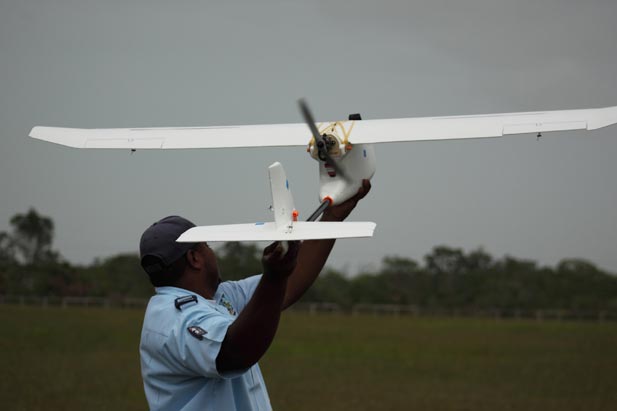Wildlife Conservation Society Helps Safeguard Belize’s Barrier Reef with Conservation Drones

Photo credit: Julio Maaz/Wildlife Conservation Society. Michael Sabal, an official from the Belize Fisheries Department about to deploy a conservation drone. The government of Belize will use drones to enforce fishing regulations over Glover’s Reef Marine Reserve and other marine protected areas in the waters off Belize.
Seeking to gain a high-tech edge over illegal fishers, the Government of Belize will use “eyes in the sky” to enforce fishing regulations in the biodiverse Glover’s Reef Marine Reserve and other reef systems in what is the first use of conservation drones to monitor marine protected areas.
With technical assistance from the Wildlife Conservation Society, the Belize Fisheries Department initiated a new monitoring program using unmanned aerial vehicles (i.e. conservation drones) to curtail unsustainable levels of illegal fishing. Besides coastal development, unregulated and unreported fishing are some of the largest threats to Belize’s fishing industry.
“Belize has been a leader in the establishment of marine protected areas, including the world-famous Glover’s Reef Marine Reserve, but fishing regulations are difficult to enforce on the open sea,” said Julio Maaz, Communities Fisheries Coordinator for WCS’s Marine Program in Belize. “Drones offer a means of improving the rate of detection of illegal activities at a fraction of the cost required for patrol vessels.”
Conservation drones also are being used for wildlife monitoring and for support in the enforcement of terrestrial protected areas. The unmanned aerial vehicles can fly autonomously for over an hour at a time with a range of more than 50 kilometers, and are capable of taking high-resolution photographs and video.
Program participants from WCS, the Belize Fisheries Department, and Conservation Drones.org fully implemented the drone program in early June, following testing that began last July. The drones will enable government officials to remotely locate fishing vessels illegally operating in marine protected areas or in areas with seasonal closures. Once located, patrol vessels can conduct seagoing searches more efficiently.
Drones will also allow government officials to monitor for illegal activities in coastal areas, which are often hidden from view by mangrove forests. Fishers have been known to hide illegal conch catches in these coastal forests.
WCS has also provided key technical support for the government’s revision of the National Fisheries Act, expected to be passed later this year. The act includes numerous improvements for the country’s legal framework for fisheries management, including rights-based reform and an adherence to ecosystem-based standards.
“This exciting new enforcement tool will help the government and local communities protect their most valuable assets—the fisheries and coral reefs of Belize’s coastal waters,” said Dr. Caleb McClennen, Executive Director of WCS Marine Conservation. “The world’s oceans are in dire need of low cost innovations for improving the cost efficiency and effectiveness of enforcement efforts. This represents an exciting pilot program for Belize, the wider Caribbean, and nearshore marine parks and fisheries around the world.”
Wildlife Conservation Society (WCS)
MISSION: WCS saves wildlife and wild places worldwide through science, conservation action, education, and inspiring people to value nature. VISION: WCS envisions a world where wildlife thrives in healthy lands and seas, valued by societies that embrace and benefit from the diversity and integrity of life on earth. To achieve our mission, WCS, based at the Bronx Zoo, harnesses the power of its Global Conservation Program in more than 60 nations and in all the world’s oceans and its five wildlife parks in New York City, visited by 4 million people annually. WCS combines its expertise in the field, zoos, and aquarium to achieve its conservation mission. Visit: www.wcs.org; http://www.facebook.com/TheWCS; http://www.youtube.com/user/WCSMedia Follow: @thewcs.
Wildlife Conservation Society's New York Aquarium is open every day of the year. Summer hours are 10 a.m. to 6 p.m. daily. Fall/winter/spring hours are 10 a.m. to 4:30 p.m., daily. Admission is $9.95 per person; children under 3 years of age are admitted free. Fridays after 4 p.m. in the summer and after 3 p.m. in the fall, admission is by pay-what-you-wish donation. The aquarium is located on Surf Avenue at West 8th Street in Coney Island. The New York Aquarium is located on property owned by the City of New York, and its operation is made possible in part by public funds provided through the New York City Department of Cultural Affairs. For directions, information on public events and programs, and other aquarium information, call 718-265-FISH or visit our web site at http://www.nyaquarium.com. Now is the perfect time to visit and show support for the WCS New York Aquarium, a beloved part of Brooklyn and all of the City of New York. Due to Hurricane Sandy we are partially opened. Check our website for more information. www.nyaquarium.com.
Media Contact
All latest news from the category: Ecology, The Environment and Conservation
This complex theme deals primarily with interactions between organisms and the environmental factors that impact them, but to a greater extent between individual inanimate environmental factors.
innovations-report offers informative reports and articles on topics such as climate protection, landscape conservation, ecological systems, wildlife and nature parks and ecosystem efficiency and balance.
Newest articles

Superradiant atoms could push the boundaries of how precisely time can be measured
Superradiant atoms can help us measure time more precisely than ever. In a new study, researchers from the University of Copenhagen present a new method for measuring the time interval,…

Ion thermoelectric conversion devices for near room temperature
The electrode sheet of the thermoelectric device consists of ionic hydrogel, which is sandwiched between the electrodes to form, and the Prussian blue on the electrode undergoes a redox reaction…

Zap Energy achieves 37-million-degree temperatures in a compact device
New publication reports record electron temperatures for a small-scale, sheared-flow-stabilized Z-pinch fusion device. In the nine decades since humans first produced fusion reactions, only a few fusion technologies have demonstrated…





















